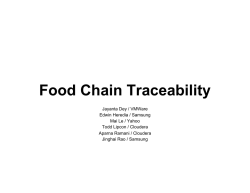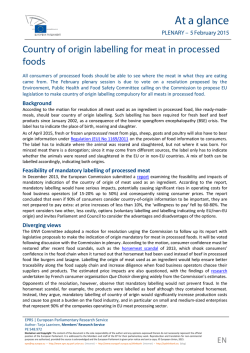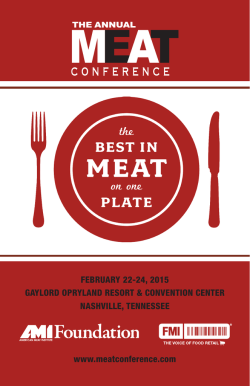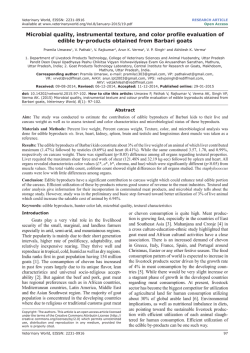
The importance of traceability in certification the quality of animal
M PRA Munich Personal RePEc Archive The importance of traceability in certification the quality of animal products Lidia Iurchevici and Rodica Chetroiu The Research Institute for Agriculture Economy and Rural Development, The Research Institute for Agriculture Economy and Rural Development 20. November 2014 Online at http://mpra.ub.uni-muenchen.de/61733/ MPRA Paper No. 61733, posted 1. February 2015 06:28 UTC THE IMPORTANCE OF TRACEABILITY IN CERTIFICATION THE QUALITY OF ANIMAL PRODUCTS IURCHEVICI LIDIA,1 CHETROIU RODICA 2 Abstract: Traceability in Productis system is an innovative approach to verify the origin of food, which will have a significant impact both on final consumers, legislators and producers from the food industry, involving large cost savings. With a food traceability system according to HACCP / ISO 22000, it can intervene and recall from market at any time, precise on lot and batch, entirely and from every point of sale, the product that of a reason or other requests this thing. The traceability is seen as a way of ensuring the control, quality and efficiency. Keywords: traceability, food safety, consumers INTRODUCTION The traceability is the capacity to identify and track a foodstuff, a forage for animals, an animal or a substance intended or expected to be incorporated into a food or a forage, at all levels of production, processing and distribution. In accordance with this definition, traceability is a process that covers the entire supply chain and in which different companies collaborate to optimize the interfaces determined of various directions, domains and sub-processes. Therefore, in our opinion, this is the way to meet consumer expectations in terms of safety and quality of products. The current food safety policy is based on a number of principles which applied in accordance with the integrated approach „from farm to fork”, specifically include transparency, risk analysis and prevention, protection of consumer interests and the free circulation of safe and quality products in the internal market and in relation with other states. In the food policy in Romania, food safety plays an important role in the global concept of nutrition. Food safety is, for the most part, subject to the environment state and resources: biodiversity; level of pollution; water, soil, resources; climate changes; human factors and globalization. The traceability and quality of meat and meat products are requirements for domestic and European market, which require, in turn, an adequate infrastructure, equipments and service network. MATERIAL AND METHOD Traceability is a solution for the consumer protection, but also an instrument of control and delineation of responsibility. If a product or a greater amount of foodstuff were altered, the producer, through a traceability system, has the capacity to check if the reason is generally related to the entire lot or batch. Or is a situation well defined and precise and the cause of this event must be investigated at dealer: the mode of storage and manipulation, presentation mode and circumstances, exposure etc. The traceability as a process of the distribution chain, can be conducted in two distinct directions: tracking forward or downward traceability (capacity to locate a product, based on specific criteria, at any point of the distribution chain) and tracking back or ascending traceability (capacity to identify the origin and characteristics of a product based on criteria established in a uniform manner for all points of the distribution chain). Through the traceability of meat products, are managed and monitored informative data on the origin of the materials, the processing history and deliveries to the points of sale. The meat processing enterprises are involved in a network of chains (livestock, slaughtering, meat transport, 1 Eng. Iurchevici Lidia – Scientific researcher III, The Research Institute for Agriculture Economy and Rural Development, e-mail: [email protected] 2 Eng. Chetroiu Rodica – Scientific researcher, The Research Institute for Agriculture Economy and Rural Development, e-mail: [email protected] wholesale trade and detail trade), with common interconnection points. The traceability is referring at projecting and implementation of processes in accordance with the system requirements. According to CAC - Codex Alimentarius Commission 60-2006, traceability means the capacity to track the movement of a specific food at different stages of production, processing and distribution. RESULTS AND DISCUSSIONS The traceability of the food products is done by chaining the information regarding raw material (for example - meat) and secondary on the entire production process. The meat traceability can be achieved because the production process in the meat industry has some major steps and well defined, which differ depending on the recipe and technology. A sector with major problems in ensuring product and service quality is the production and distribution of food. In this sector was and is needed by many food safety regulations. Events such as bovine spongiform encephalopathy, the flocks of some Western European countries, dioxin contamination of poultry, swine pest and others, have made European consumer confidence, and not only, in the products they consume, to be seriously affected; consequently, it caused a real crisis on the Unique Market. Therefore, the food security has become top priority to regain the consumer confidence. The beef market was the most affected. To remove the problems in this sector, the European Commission has commissioned a fast form of trace of bovine meat in the distribution chain. Moreover, at the proposal of the European Commission, the Council and the European Parliament adopted a Regulation of mandatory labeling of bovine meat - CE No. 1760/2000 that became mandatory in all EU countries, since January 2001. It complements other Community legislation particularly important, namely the European Directive 820/97 (entered into force on 01.01.2000), which amends, in an irreversible form, the bovine meat chain operation, requiring the parties to link the physical flow of products to the information flow, thus ensuring the traceability of beef. Realizing the complexity of this regulation, the Association of EAN International (EAN - European Article Numbering) by 16 national numbering bodies from Europe, along with 17 other community organizations and European leaders in the bovine meat trade, have made the traceability system „Traceability of Beef” based on barcode UCC / EAN-128 (SREN 799: 1998) and IA application identifiers (SREN 1571: 1998). This system is used worldwide today; it meets all EU regulations and makes possible the quality certification for the enterprises in the meat processing industry. Identification and traceability solutions include the physical flow of animals, intermediate products (carcasses and chopped) and finished products (meat packing) throughout the meat chain. The communication solutions of the EAN system refer to the information flow in the chain. In general, companies are not involved in one chain, but in a network of chains (livestock, meat, retail), with common interconnection points. By traceability of meat products is intended to provide data on the origin and processing history. For this, it is necessary that the meat chain to communicate permanently with the chain of the animals slaughtered to obtain the meat. To ensure a correct, reliable and cost effective application of the EU Directive 820/97, without creating trade barriers, the suppliers of carcasses and cut meat must identify their own products using EAN-128 bar code. Thus, printing the additional information on the package could be integrated in the existing process of EAN-13 labeling. Also in the food sector, in terms of consumer protection and safety, there have been recorded numerous cases determined of the marketing products with a high content of harmful substances used as food additives, products in which occurred genetic manipulation of organisms etc. All these have determined the community organizations to develop new proposals and elaborate new hygiene rules for the production of food commodities. The chemicals introduced into food as additives were coded by the letter E, followed by three digits. Additives considered as hazardous to the human body (eg: E123, E142, E211) are banned in the EU, USA, CIS. The European Commission has approved a proposal of the Parliament and the Council by which was established The European Food Authority - EFA, the body which cooperates with FAO, OMS, consumer protection bodies, etc. A topical issue of these Community bodies is to develop regulations on the traceability of all foods and food ingredients. To achieve the requirements under this principle, the new regulations will require registration of any food business and numbering products. The evidence of suppliers of ingredients, semi-finished and finished food products will be mandatory in all sectors of the food industry. The instruments of EAN / UCC system are fully capable of meeting the requirements of these regulations, for example: The numbering system of commercial items and locations allow the safe international identification of commercial items and suppliers; Symbolization by the barcodes EAN-13, EAN-8 or UPC-A and UPC-E, and UCC / EAN128, all accompanied by international standards ISO and European standards EN, enable transposition on labels of information about the producers and providers in standardized format. The concentration of these data using Application Identifiers - AI in barcode UCC / EAN-128 makes possible the traceability of food products. The EAN / UCC system was designed to provide standardized, unambiguous means of identification items and companies operating in different points of the national and international distribution chain. The identification data, traceability, shelf life, etc. encoded in the bar code does not replace the information clearly on the product label. These data must be identical to those listed in clear format on the label. The traceability of food products is an indicator of the power of company on the food market. Traceability on the production line is according to HACCP / ISO 22000 (risk analysis on critical control points). This indicates the power and compliance of the producing food company that consists in building and strengthening consumer confidence in the own products because it has total control over the traceability both on own production and on the market. A food safety hazard is any biological, chemical or physical agent present in food, with the potential to cause an adverse health effect. Risk is an estimate of the probability and severity of a hazard, is a function of probability of an adverse effect (an item of microbiological, chemical or physical nature) on the health and the severity of that effect (death, hospitalization, absence from work, etc. ). The risks are often encountered in the activities with food products, when food may endanger the public health. The major risks must be distinguished from the minor. A risk is major if: There is an increased probability that „risky” food to be consumed The emergence of risk has serious consequences for public health (eg. glass shards in jam, nails, wire in the bakery products) There is an increased probability that consumer health will suffer from it. Typical critical control points are: A metal detector to identify fragments of metal in the finished product. A stage of heat treatment specifically projected to destroy pathogens or to adjust the pH of acidified products, in order to control the pathogens. Establish critical limits Critical limits are the criteria that distinguish between „safe” and potentially „unsafe”, are defined by law, safety standards and values scientifically demonstrated and represent measurable parameters that can be determined and monitored. Monitoring requires a systematic measurement or observation of the critical control point regarding the critical limits. Examples of factors that must be defined before the start of the monitoring procedure: Approach - check the expiry date, the cold store temperature and storage period Frequency - weekly or daily if necessary Responsibility of the economic operator, kitchen manager, chef The establishing of the procedures that are performed regularly and operate efficiently is based on: Verification: Confirm the correctitude of something by control Verification of HACCP system (Hazard Analysis of Critical Control Points) through its operating capacity. It is confirmed that the activity involved by the HACCP program is carried out effectively, correctly and logically. The process must be checked at least once a year and between periods of change procedures or compositions. An example of change would be to extend your range of products which involves adding new operations. For storing full records to prove for example the efficiency or for the inspection of the representatives of authorities, all HACCP stages must be documented. In addition, the HACCP concept is a valuable tool that brings to consumer evidence if there are complains or even food poisoning. HACCP documents must be retained even after expiring of the product, without exception. Food business operators are legally required by EU legislation: to show the authorities that respects the principles of HACCP to update procedures / documents of the food safety system, whenever changes occur (eg. a new recipe that requires a new technological flow and different process parameters) to keep the documents and records for an appropriate period With a food traceability system according to HACCP / ISO 22000, it can intervene and recall from market at any time, precise on lot and batch, entirely and from every point of sale, the product that of a reason or other requests this thing. The traceability is seen as a way of ensuring the control, quality and efficiency. Traceability in Productis system is an innovative approach to verify the origin of food, which will have a significant impact both on final consumers, legislators and producers from the food industry, involving large cost savings. CONCLUSIONS The food sector enterprises that want to maintain or strengthen their market position, must take drastic measures in the future to ensure quality, traceability, logistics efficiency and information sharing. By applying these measures is aimed at: database on production, processing, marketing of food products; sustainable increasing of internal production of food by reducing the risks, dangers and losses throughout the production chain to the consumer and minimize as much as possible the food waste; preventive security by supporting distributors and consumer confidence for products sold; possibility of safe operation in the event of irregularities of the product (retrieval and withdrawal of goods, or locating the source of the problem, to prevent its spreading); delimitation of responsibility in the traceability chain; the shipping code using - SSCC - as key in the logistics processes to ensure better traceability. The paper will have a positive impact in terms of technical, also on the economic agents, in terms of increasing the quality of food offered to the market, by compliance with the techniques and application of technologies recommended by adopting traceability system and ensure compatibility with other systems at national and international levels in order to ensure transparency and confidence with the business partners. BIBLIOGRAPHY 1. 2. Eugenia Alecu şi colaboratorii , Trasabilitatea – element cheie al transparentei Editura Ceres, Bucureşti, 2010; Mariana Grodea (2013), coautor Cap. Piaţa laptelui în România – evoluţii şi tendinţe post-aderare, publicata în Determinanţi economici, sociali şi instituţionali ai performanţelor şisecurităţii alimentare, Păun Ion Otiman, Filon Toderoiu, Elena Sima (coord), Editura AcademieiRomâne, Bucureşti, 604 pagini, pag. 301-316, ISBN 978973-27-2367-8; 3. 4. INFO EAN ROMANIA, Buletin trimestrial de informare, Editura GENICOD, Bucureşti, Colecţiile: 2002, 2003, 2004, 2006; Istudor Nicolae, Proiectarea unui sistem informaţional pentru monitorizarea trasabilităţii în producţia cărnii de porc, Bucureşti, 2010.
© Copyright 2026




